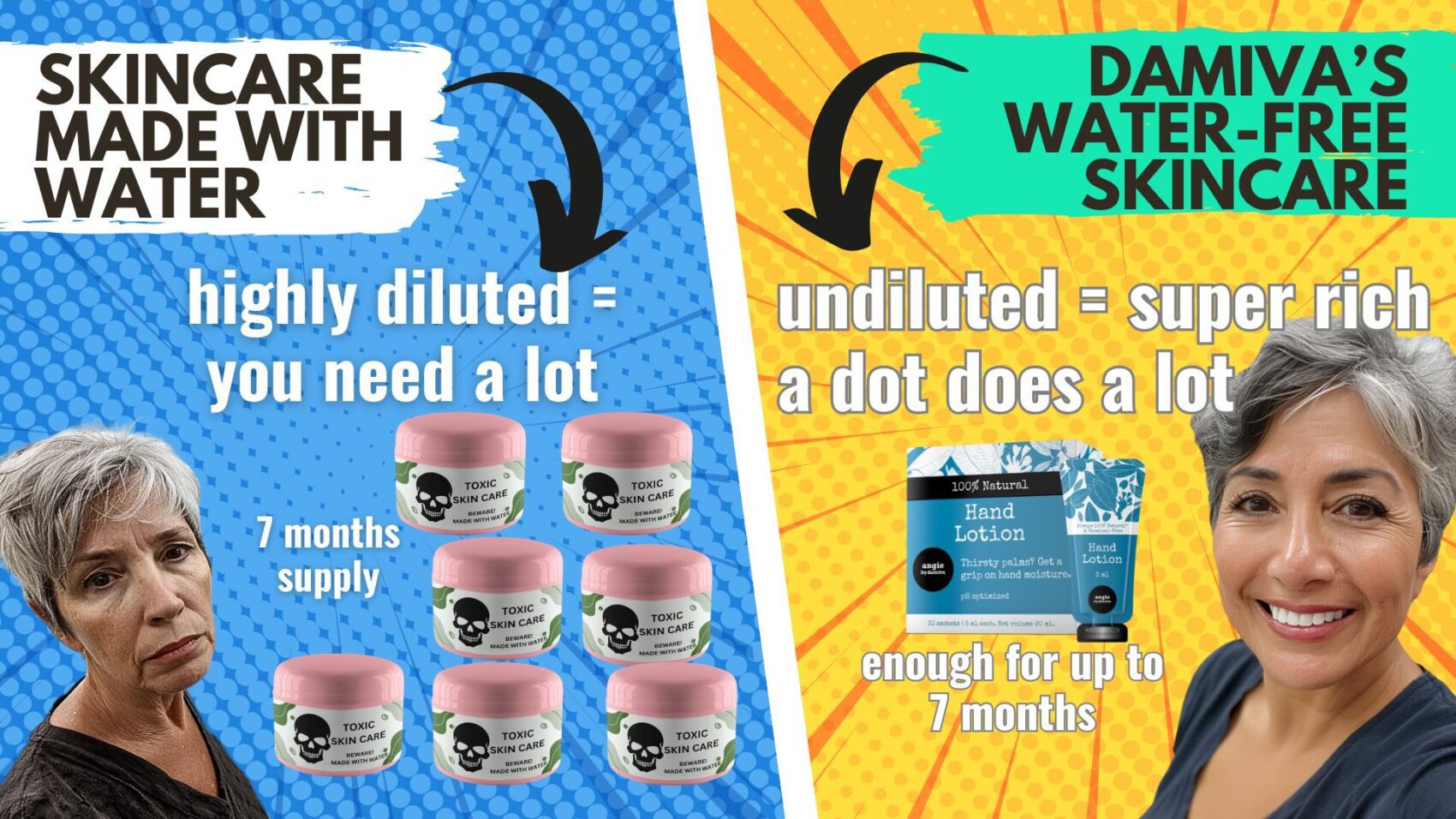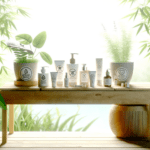Introduction
Understanding the Need for Chemical-Free Skincare
In recent years, the beauty industry has witnessed a significant shift towards clean beauty. Consumers are increasingly aware of the ingredients in their skincare products and are seeking safer, non-toxic alternatives. This trend has led to the rise of clean beauty products that prioritize health and well-being over harsh chemicals. But what does clean beauty mean, and why is there a growing need for chemical-free skincare?
Clean beauty encompasses products made without harmful ingredients. These products focus on transparency, safety, and sustainability. They exclude ingredients like parabens, sulfates, phthalates, and synthetic fragrances, which are known to cause irritation or long-term health concerns. Instead, clean beauty products utilize natural and organic ingredients that are gentle on the skin and environmentally friendly.
The Risks of Conventional Skincare Products
Conventional skincare products often contain a myriad of chemicals that can be harmful to both your skin and overall health. Some of the most common toxic ingredients include parabens, synthetic fragrances, and mineral oils. Parabens, used as preservatives, have been linked to hormone disruption and early puberty in girls. Synthetic fragrances can cause allergic reactions and may contain undisclosed harmful chemicals. Mineral oils, while effective at creating a barrier on the skin, can clog pores and may contain contamination toxins.
Moreover, many of these chemicals are bioaccumulative, meaning they build up in the body over time and can lead to long-term health issues. Persistent bioaccumulative toxic chemicals (PBTs) are particularly concerning as they are used in some pesticides and find their way into our waterways, food chain, and ultimately, our bodies. Increased exposure to these chemicals has been linked to reproductive health issues, asthma, hormonal problems, infertility, cancer, and neurological problems.
Benefits of Transitioning to Chemical-Free Skincare
Switching to chemical-free skincare offers numerous benefits. Firstly, it reduces your exposure to harmful chemicals that can disrupt hormones and cause skin irritations. Clean skincare products are designed to work in harmony with your skin’s natural processes, promoting healthier and more radiant skin. Additionally, these products often come with eco-friendly packaging, contributing to a reduced environmental footprint.
Natural skincare products are also packed with essential nutrients that nourish the skin. Ingredients like hyaluronic acid, vitamin C, and CoQ10 are known for their hydrating, brightening, and anti-aging properties. These natural ingredients support the skin’s health without the side effects associated with synthetic chemicals.
Furthermore, transitioning to chemical-free skincare can be cost-effective in the long run. While natural products may seem more expensive initially, they often provide better results and reduce the need for additional treatments or products. Investing in quality, non-toxic skincare can save you money and contribute to your overall well-being.

Do you have the most commonly used but toxic, disease bringing chemicals in your skin care? Many chemicals in skincare are hormone disruptors and make menopause symptoms worse.
Find out more…
Identifying Harmful Ingredients
Common Toxic Ingredients in Skincare
Many conventional skincare products contain ingredients that can be harmful to your health. Here are some of the most common toxic ingredients to watch out for:
- Parabens: These preservatives, found in many cosmetics, lotions, and deodorants, are linked to endocrine disruption and breast cancer.
- Phthalates: Often hidden under “fragrance” on labels, phthalates are known endocrine disruptors and have been linked to reproductive issues and cancer.
- Formaldehyde: A known carcinogen, formaldehyde can cause skin allergies and tissue irritation. It is often found in a variety of cosmetics.
- Sodium Lauryl Sulfate (SLS): Common in foaming products like shampoos and body washes, SLS can cause skin irritation and eye damage.
- Triclosan: Found in antibacterial products, triclosan is suspected of causing endocrine disruption and contributing to antibiotic resistance.
- Heavy Metals: Ingredients like lead, mercury, and arsenic can be found in makeup and skincare products, posing risks of neurotoxicity and organ damage.
Understanding Endocrine Disruptors
Endocrine disruptors are chemicals that can interfere with the endocrine (hormone) system. These disruptions can cause cancerous tumors, birth defects, and other developmental disorders. Common endocrine disruptors found in skincare products include:
- Phthalates: These are often used to make plastics more flexible and are found in many personal care products.
- Parabens: Used as preservatives, parabens can mimic estrogen and disrupt hormonal balance.
- Triclosan: An antibacterial agent that can affect thyroid hormone concentrations.
The impact of these chemicals can be profound, affecting not just individual health but also public health. Long-term exposure can lead to hormonal imbalances, reproductive issues, and increased cancer risk.
How to Read and Interpret Labels
Navigating the ingredient lists on skincare products can be daunting, but it’s crucial for avoiding harmful chemicals. Here are some tips to help you decode those labels:
- Use Online Resources: Tools like the Environmental Working Group’s (EWG) Skin Deep database, Think Dirty, and CosDNA can help you check the safety of ingredients.
- Beware of Misleading Labels: Terms like “natural” and “organic” are not strictly regulated. Always check the ingredient list for harmful chemicals.
- Look for Certifications: Certifications like USDA Organic, Ecocert, and Cosmos can provide some assurance of product safety.
- Understand Common Terms: Ingredients like “fragrance” can hide a multitude of chemicals. Opt for products that disclose all their ingredients.
By becoming more informed about the ingredients in your skincare products, you can make safer choices and protect your health.
Do you know the 3 main ways how your body is exposed to harmful chemicals, which affect your hormones, your thyroid, health and beauty?
If not, it may be time to learn about them. It takes about 1-2 minutes.
We have a few suggestions how to avoid these silent health and immune system killers in our new guide.
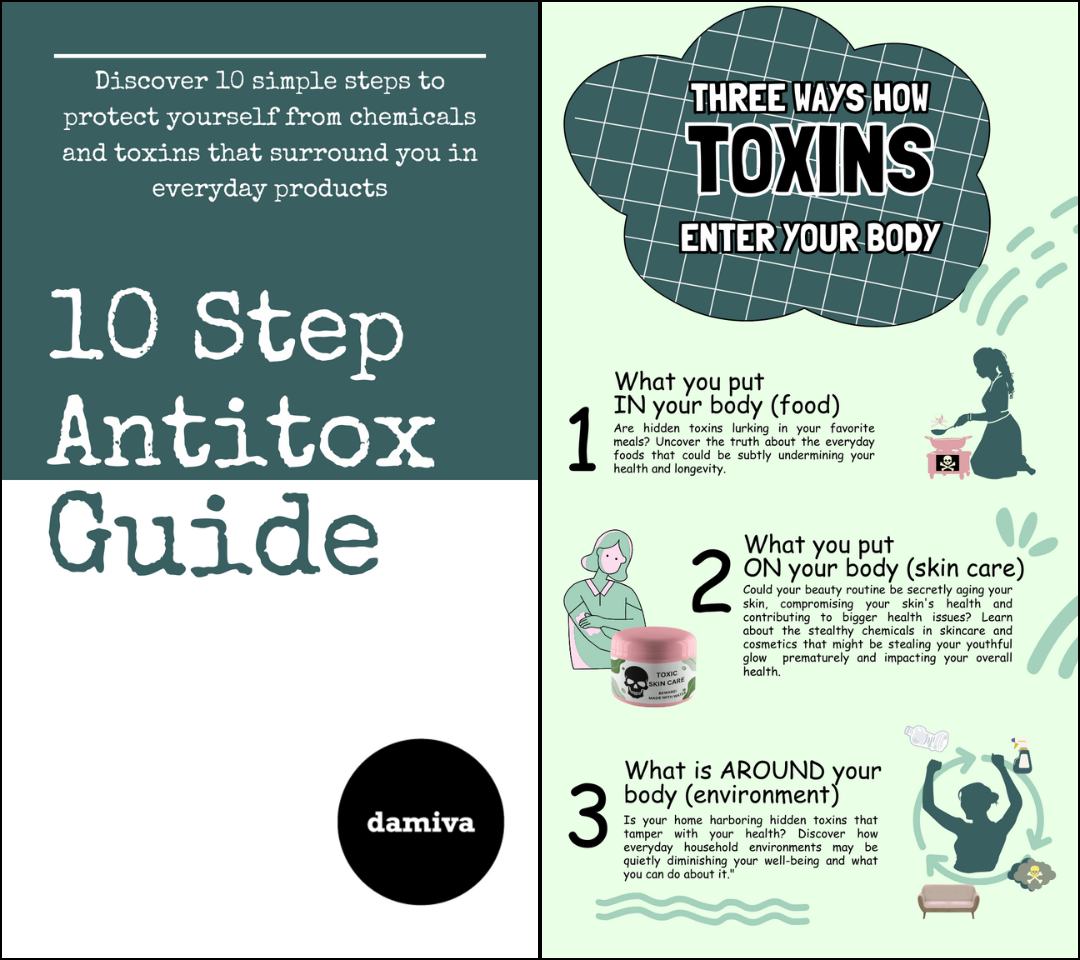
Steps to Transition to Chemical-Free Skincare
Assessing Your Current Skincare Routine
Before making any changes, it’s crucial to evaluate your existing skincare routine. Take a close look at the products you use daily, from cleansers and toners to moisturizers and sunscreens. Check the ingredient lists for harmful chemicals such as parabens, phthalates, sulfates, and synthetic fragrances. Make a note of which products contain these ingredients and prioritize them for replacement. This initial assessment will help you understand the extent of your current exposure to toxic substances and set a clear path for transitioning to safer alternatives.
Gradual Replacement of Products
Switching to a chemical-free skincare routine doesn’t have to happen overnight. Gradual replacement is a more sustainable and less overwhelming approach. Start by replacing the products that cover the largest surface area of your skin, such as body lotions and sunscreens. Next, move on to facial products like cleansers, toners, and moisturizers. Finally, replace specialized items like serums and masks. This step-by-step method allows your skin to adjust to new products gradually, reducing the risk of irritation or breakouts.
DIY Skincare Recipes
One of the most empowering ways to ensure your skincare is chemical-free is to make your own products. DIY skincare recipes often use simple, natural ingredients that you can find in your kitchen or local health store. For example, a basic facial scrub can be made with sugar and coconut oil, while a hydrating mask might include honey and avocado. Not only are these recipes cost-effective, but they also allow you to control exactly what goes onto your skin. Here are a few easy recipes to get you started:
- Exfoliating Scrub: Mix 1 tablespoon of sugar with 1 tablespoon of coconut oil.
- Hydrating Mask: Blend 1/2 avocado with 1 tablespoon of honey.
- Toner: Combine equal parts apple cider vinegar and distilled water.
Consulting with a Dermatologist
While DIY recipes and gradual replacement are excellent steps, consulting with a dermatologist can provide personalized guidance tailored to your skin type and concerns. A dermatologist can recommend specific chemical-free products and treatments that are effective and safe. They can also help you navigate any initial breakouts or skin reactions that may occur as your skin adjusts to new products. Professional advice ensures that your transition to a chemical-free skincare routine is both effective and safe.
By following these steps, you can make a smooth and informed transition to a chemical-free skincare routine, ultimately benefiting your skin’s health and overall well-being.
Benefits of Natural Ingredients
Popular Natural Ingredients and Their Benefits
Natural skincare ingredients have gained popularity for their effectiveness and minimal side effects. Here are some commonly used natural ingredients and their benefits:
- Aloe Vera: Known for its soothing and hydrating properties, aloe vera is excellent for treating sunburns, reducing inflammation, and moisturizing the skin.
- Coconut Oil: This versatile oil is rich in fatty acids and antioxidants, making it an excellent moisturizer and anti-aging agent. It also has antimicrobial properties that can help with acne.
- Shea Butter: High in vitamins A and E, shea butter is a superb moisturizer that helps to heal dry skin and improve elasticity.
- Tea Tree Oil: Known for its antiseptic and anti-inflammatory properties, tea tree oil is effective in treating acne and other skin infections.
- Honey: A natural humectant, honey helps to retain moisture in the skin. It also has antibacterial properties that can help with acne and wound healing.
- Jojoba Oil: Similar in composition to the skin’s natural sebum, jojoba oil is excellent for balancing oil production and providing hydration without clogging pores.
How Natural Ingredients Support Aging Skin
Aging skin requires special care to maintain its elasticity, hydration, and overall health. Natural ingredients can play a significant role in supporting aging skin:
- Antioxidants: Ingredients like green tea, vitamin C, and pomegranate are rich in antioxidants that help to neutralize free radicals, which can cause premature aging.
- Hydration: Natural oils such as argan oil and rosehip oil are excellent for providing deep hydration, which is crucial for maintaining skin elasticity and reducing the appearance of fine lines and wrinkles.
- Collagen Boosters: Ingredients like hyaluronic acid and peptides found in natural sources can help to boost collagen production, improving skin firmness and reducing sagging.
- Anti-inflammatory Properties: Ingredients like chamomile and calendula help to reduce inflammation and redness, which can be more pronounced in aging skin.
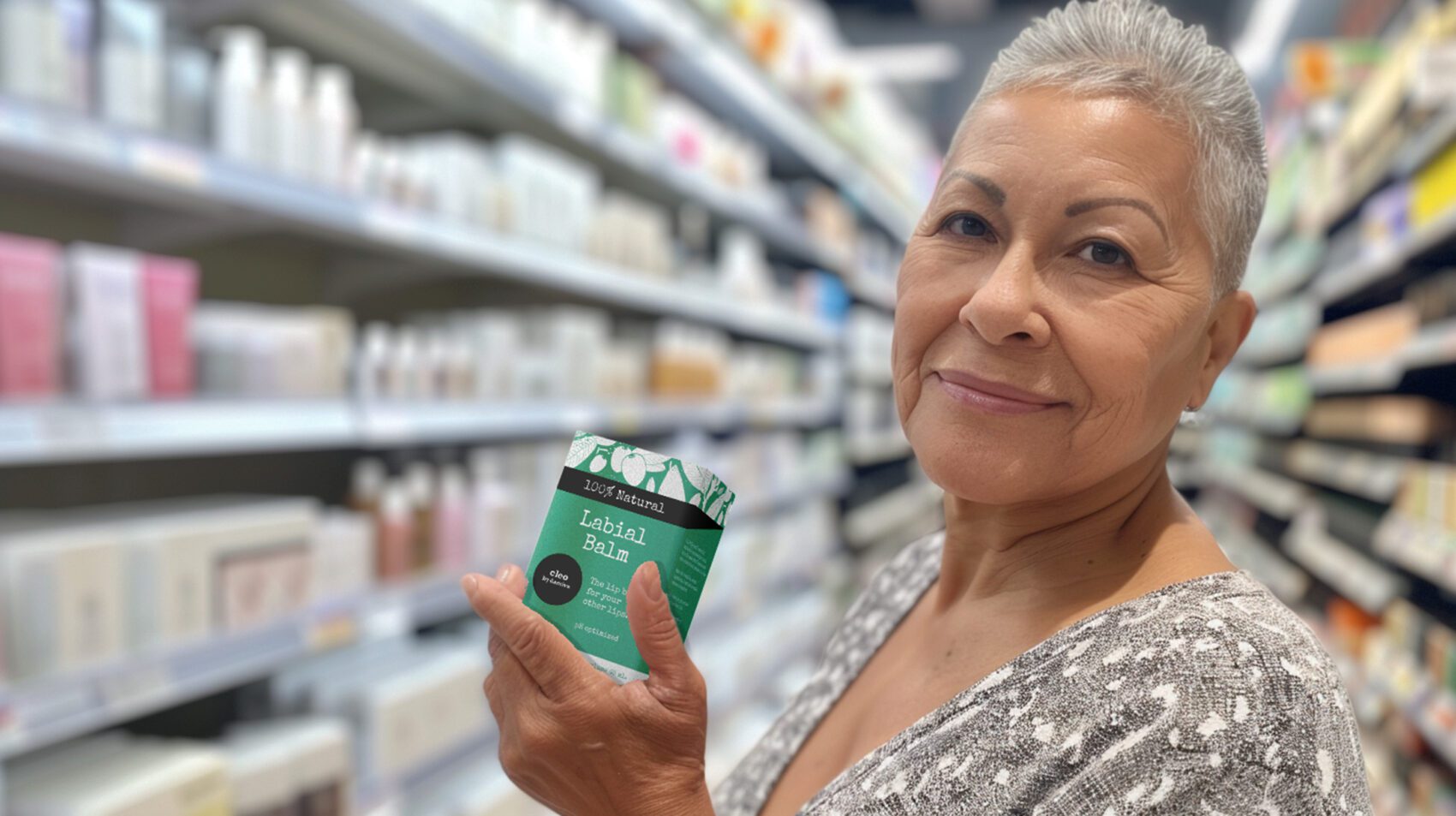
⭐️⭐️⭐️⭐️⭐️
“I needed a product like this for medical reasons. Thanks to this product I was able to do my physical therapy. The formula is very comfortable. It provides the right amount of lubrication. I will continue to use. I’m very happy to have found this because nothing else was working.”
Beatriz E, Cleo Customer
Case Studies: Success Stories
Many individuals have experienced significant improvements in their skin health by switching to natural skincare products. Here are a few success stories:
Case Study 1: Sarah’s Journey to Clear Skin
Sarah struggled with acne for years and tried numerous conventional treatments with little success. After switching to a natural skincare routine that included tea tree oil and honey masks, she noticed a significant reduction in breakouts and an overall improvement in her skin texture.
Case Study 2: John’s Anti-Aging Transformation
John was concerned about the fine lines and wrinkles that started appearing in his late 40s. He began using a natural skincare regimen that included rosehip oil and green tea extract. Within a few months, he observed a noticeable reduction in wrinkles and an improvement in skin elasticity.
Case Study 3: Emma’s Eczema Relief
Emma had been dealing with eczema flare-ups for most of her life. After consulting with a dermatologist, she switched to a natural skincare routine that included aloe vera and shea butter. Her skin became more hydrated, and the frequency and severity of her eczema flare-ups decreased significantly.
These case studies highlight the potential benefits of natural ingredients in skincare. While individual results may vary, many people find that natural products offer a gentler and more effective solution for their skin concerns.
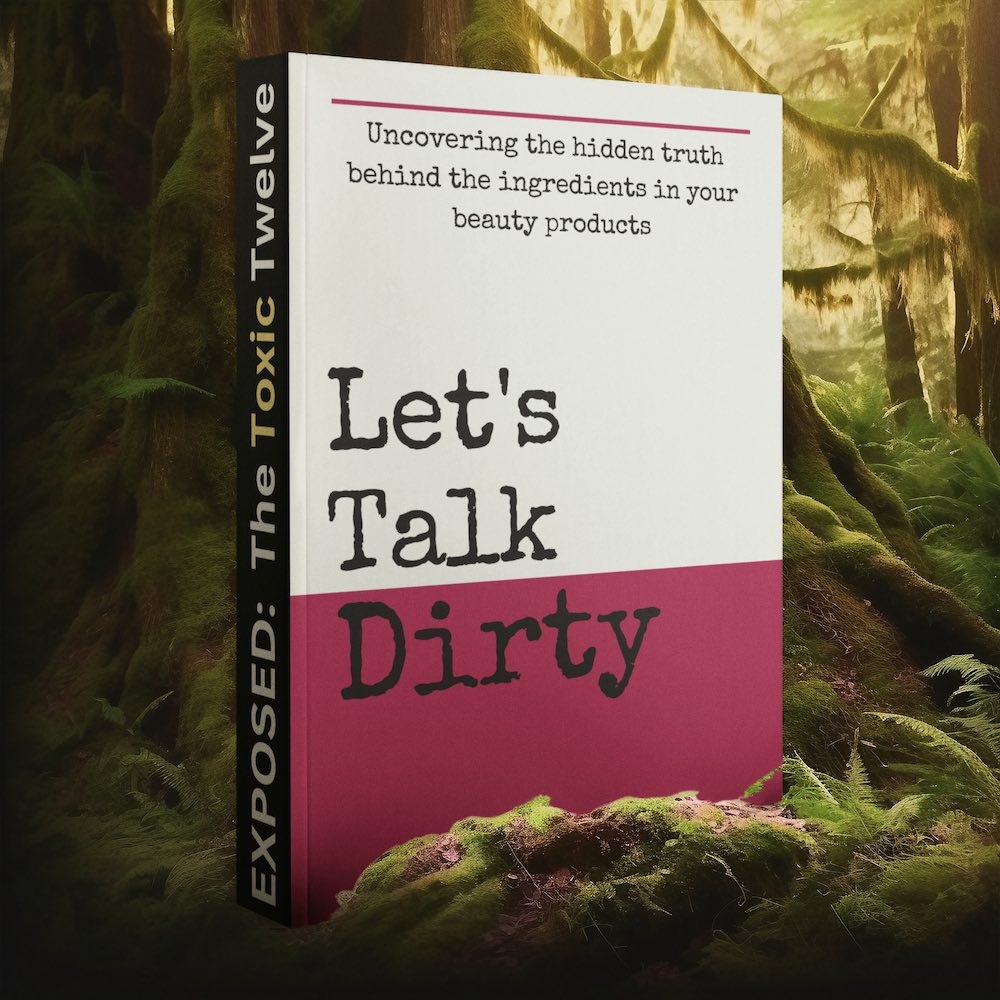
Feeling You Have a Right to Safe Beauty & Fem Care?
If so, it may be time for a change. It starts with knowledge. We have a few suggestions in our new guides.
Maintaining a Chemical-Free Skincare Routine
Daily Skincare Practices
Maintaining a chemical-free skincare routine requires consistency and dedication. Here are some essential daily practices to keep your skin healthy and glowing:
- Cleansing: Use a gentle, natural cleanser to remove dirt, oil, and makeup without stripping your skin of its natural oils. Look for ingredients like honey, aloe vera, and natural oils.
- Toning: Apply a natural toner to balance your skin’s pH and prepare it for moisturizing. Rosewater or witch hazel are excellent choices.
- Moisturizing: Hydrate your skin with a natural moisturizer. Options include oils like jojoba or argan oil, or creams made with shea butter and essential oils.
- Sun Protection: Use a natural sunscreen with ingredients like zinc oxide or titanium dioxide to protect your skin from harmful UV rays.
Consistency is key. Stick to your routine every morning and evening to see the best results.
Seasonal Adjustments
Your skin’s needs can change with the seasons, so it’s important to adjust your routine accordingly:
- Winter: Cold weather can dry out your skin. Opt for richer, more hydrating products like shea butter or heavier oils. Consider using a humidifier to add moisture to the air.
- Summer: In warmer months, your skin may produce more oil. Switch to lighter moisturizers and ensure you use a natural sunscreen. Aloe vera gel can be soothing after sun exposure.
- Spring and Fall: These transitional seasons can cause your skin to fluctuate. Pay attention to your skin’s needs and adjust your products accordingly. Exfoliate gently to remove dead skin cells and allow better absorption of your skincare products.
Long-Term Benefits and Expectations
Transitioning to a chemical-free skincare routine offers numerous long-term benefits:
- Healthier Skin: Natural ingredients nourish your skin without the risk of harmful side effects. Over time, you may notice fewer breakouts, reduced irritation, and a more even skin tone.
- Environmental Impact: Using natural products reduces your environmental footprint. Many chemical-free products come in eco-friendly packaging and are made with sustainable practices.
- Holistic Well-being: A chemical-free routine aligns with a holistic approach to health, promoting overall well-being. Knowing that you are using safe, natural products can also provide peace of mind.
It’s important to set realistic expectations. While natural products can be highly effective, they may take longer to show results compared to their chemical-laden counterparts. Patience and consistency are crucial. Over time, you will likely find that the benefits far outweigh the initial adjustment period.
By incorporating these practices and adjustments, you can maintain a chemical-free skincare routine that supports your skin’s health and your overall well-being.
Addressing Common Concerns
Effectiveness of Natural vs. Conventional Products
One of the most common concerns when transitioning to chemical-free skincare is whether natural products are as effective as their conventional counterparts. **Natural skincare products** often rely on plant-based ingredients, essential oils, and botanical extracts, which can be highly effective in treating various skin concerns. For instance, ingredients like *aloe vera* and *chamomile* are known for their soothing properties, while *vitamin C* and *hyaluronic acid* are celebrated for their anti-aging and hydrating benefits.
However, it’s important to note that the effectiveness of any skincare product, whether natural or conventional, largely depends on the formulation and the specific needs of your skin. While some conventional products may offer quick results due to potent synthetic ingredients, they can also come with side effects like irritation or long-term health risks. On the other hand, natural products may take longer to show results but are generally gentler on the skin and safer for long-term use.
Cost Considerations
Another significant concern is the cost associated with chemical-free skincare products. It’s true that natural and organic products can sometimes be more expensive than conventional ones. This is often due to the higher cost of sourcing natural ingredients and the rigorous processes involved in ensuring their purity and efficacy.
However, investing in chemical-free skincare can be seen as a long-term investment in your health and well-being. **Natural products** are less likely to cause adverse reactions, which can save you money on treatments for skin issues caused by harsh chemicals. Additionally, many natural products are multi-functional, meaning you may need fewer products overall. For example, a high-quality natural oil can serve as a moisturizer, makeup remover, and hair treatment, reducing the need for multiple products.
Dealing with Initial Breakouts
A common issue when switching to a new skincare routine, especially a chemical-free one, is the occurrence of initial breakouts. This can be discouraging, but it’s often a normal part of the transition process. When you start using natural products, your skin may go through a detox phase, where it purges impurities and adjusts to the new ingredients.
To manage initial breakouts, consider the following tips:
- Patch Test: Always perform a patch test before fully incorporating a new product into your routine to ensure it doesn’t cause an adverse reaction.
- Gradual Introduction: Introduce new products one at a time, allowing your skin to adjust gradually.
- Hydration: Keep your skin well-hydrated with natural moisturizers to support its barrier function during the transition.
- Consult a Dermatologist: If breakouts persist, consult a dermatologist to ensure you’re using the right products for your skin type.
In conclusion, while there are valid concerns about the effectiveness, cost, and potential initial breakouts associated with transitioning to chemical-free skincare, the long-term benefits often outweigh these challenges. By choosing natural products, you prioritize your skin’s health and overall well-being, making it a worthwhile investment.
Conclusion
Recap of Key Points
As we conclude our exploration of transitioning to chemical-free skincare, it’s essential to revisit the key points discussed. We began by understanding the need for chemical-free skincare and the risks associated with conventional products, such as the presence of endocrine disruptors and other harmful chemicals. We then delved into identifying these toxic ingredients and how to read and interpret labels effectively. The steps to transition to a chemical-free skincare routine were outlined, including assessing your current routine, gradually replacing products, and even trying DIY skincare recipes. We also highlighted the benefits of natural ingredients, their support for aging skin, and shared success stories. Finally, we discussed maintaining a chemical-free skincare routine and addressed common concerns such as effectiveness, cost, and dealing with initial breakouts.
Encouragement to Make the Switch
Transitioning to a chemical-free skincare routine is not just a trend; it’s a commitment to your health and well-being. By choosing products free of harmful chemicals, you are taking a proactive step towards reducing your body’s chemical burden. The benefits of natural ingredients, such as reduced irritation and enhanced skin health, are well worth the effort. Remember, every small change you make in your skincare routine can lead to significant long-term benefits. Embrace the journey towards a healthier, more radiant you. Your skin will thank you for it.
Resources for Further Reading
To support you in your journey towards chemical-free skincare, here are some valuable resources for further reading:
- EWG’s Skin Deep Database – A comprehensive resource for checking the safety of skincare ingredients.
- Campaign for Safe Cosmetics – An organization dedicated to eliminating harmful chemicals from personal care products.
- National Center for Biotechnology Information (NCBI) – Research articles on the effects of toxic chemicals in skincare.
- Think Dirty App – An app that helps you identify potentially toxic ingredients in your beauty products.
- Paula’s Choice: Natural Skincare – Expert advice on natural skincare ingredients and their benefits.
By leveraging these resources, you can continue to educate yourself and make informed decisions about the products you use. Transitioning to chemical-free skincare is a journey, and with the right knowledge and tools, you can achieve a healthier, more vibrant complexion.



